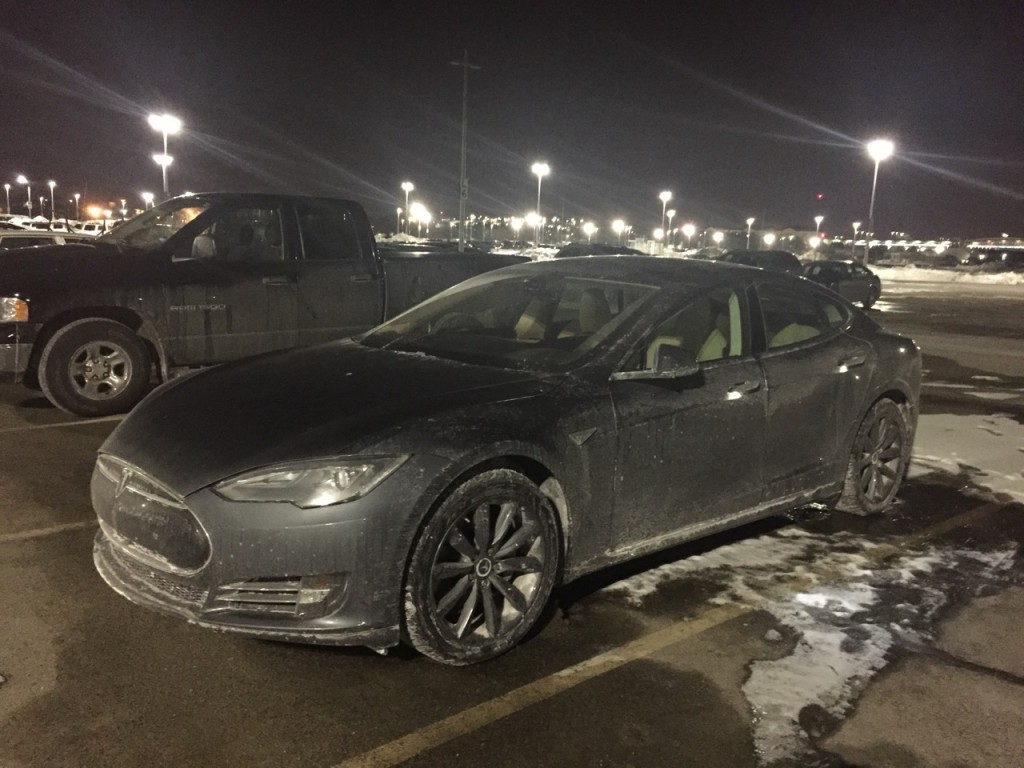

Lifestyle
A Guide to Tesla Model S Long Term Parking
One of the many joys that new Tesla owners may come across are situations where they’ll need to leave the vehicle parked for a prolonged period of time and at a location that doesn’t have a charger. The natural thought is, what will this do to the battery? I inevitably came across this same situation recently and wanted to take this opportunity to share my experiences around it.
“Tesla approved” Spot
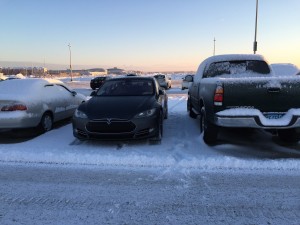 My first mission in any parking lot is to find a “Tesla approved” parking spot. That’s a spot large enough to fit the Model S but also minimize the chance that neighboring cars will leave me with unwanted door dings. This is especially the case when driving through a busy city like Boston where space comes at a premium.
My first mission in any parking lot is to find a “Tesla approved” parking spot. That’s a spot large enough to fit the Model S but also minimize the chance that neighboring cars will leave me with unwanted door dings. This is especially the case when driving through a busy city like Boston where space comes at a premium.
RELATED >>> S in the City: Model S Owner Experience in the Big City
If I can find a parking space that’s adjoined to a curb on one side, it’s a bonus — I get close enough to the curb (without scraping it!) to maximize the distance to the next space and minimize ding chances.
If I’m making my way to an airport, I know to avoid the busy short term parking garages where the hustle and bustle of pick-up and drop-off traffic is just enough for me to not want to be there. Instead I head towards the long term economy lot where my chances of any unwanted run-ins with other cars is at a minimum. There I look for my “Tesla approved” spot between two already parked cars. There’s a good chance that I’ll come and go before the other cars in the long term lot. Some parking lots also rotate parking locations for new entrants which further reduces the risk of having a new incoming car park next to me.
Minimize Vampire Drain
While Tesla has made some really great firmware improvements to address the dreaded vampire drain, there is still some battery loss when the car is not in use. Even when the car is off and stowed away for long term parking the Model S battery will still discharge albeit at a slower rate as it continues to provide power to the onboard electronics.
You can help minimize battery discharge by enabling “Energy Saving” under the “Power Management” settings on your Model S. I was able to quantify some of this loss which I’ll describe later in the post.
Battery Discharge Notes via Tesla Motors
From the user manual, Tesla says this:
Even when Model S is not being driven, its Battery discharges very slowly to power the onboard electronics. On average, the Battery discharges at a rate of 1% per day. Situations can arise in which you must leave Model S unplugged for an extended period of time (for example, at an airport when traveling). In these situations, keep the 1% in mind to ensure that you leave the Battery with a sufficient charge level. For example, over a two week period (14 days), the Battery discharges by approximately 14%.
However based on my experiences “Tesla math” when it comes to range is often optimistic and not necessarily what you’ll see in the real world.
Real World Experience
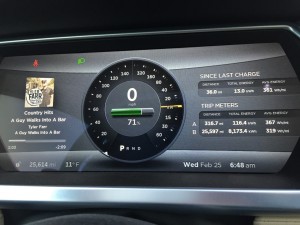 I took a short business trip to Las Vegas recently which required me to leave my Model S in long term parking for a couple of days.
I took a short business trip to Las Vegas recently which required me to leave my Model S in long term parking for a couple of days.
It was 11 degrees fahrenheit out when I parked and I had 186 miles of rated range left (71%). When I returned my Model S reported 172 miles of rated range left (65%).
I lost 14 rated miles over the 2.6 days at an average temperature of 16 degrees fahrenheit. So I lost an average of 2.3% rated range per day which is quite a bit higher than the manual indicates. This wasn’t long enough to qualify as long term parking but it’s still important to take note that the rate in battery discharge can be more than double of what you’re expecting. Plan accordingly.
While the loss was higher than I expected, I still had plenty of range to get back home and give my Model S a much needed bath.
Summary
Be smart and plan out your Model S long term parking strategy, especially if there isn’t going to be a charger on site or nearby. Be sure to have enough battery range upon return so that you can get to your destination or to the nearest charging location.
Tesla suggests a 1% battery discharge loss per day but you may want to consider a more conservative 3% number to ensure you have plenty of range left upon returning.
There are reports of Tesla owners having parked at the airport with a low state of charge only to find car the the battery was drained upon returning. Bjørn Nyland of YouTube notoriety had an experience with long term parking (27 days at an airport with no charger) which resulted in less than a 1% loss per day – obviously a much better result than I had. The video showed a temperature of 8 degrees celsius, or about 46 degrees fahrenheit which is much warmer than it was for my test which may account for the difference in battery drain.
That said, the Tesla Model S can be safely left in long term parking without a charge and still have plenty of range left to get you home. Just be sure to take into account the number of days the car will be left unattended multiplied by a 1-2% battery discharge per day and you’ll be greeted with a happy Tesla upon returning.

Lifestyle
Tesla Model S Plaid battles China’s 1500 hp monster Nurburgring monster, with surprising results
There is just something about Tesla’s tuning and refinement that makes raw specs seem not as game-changing.
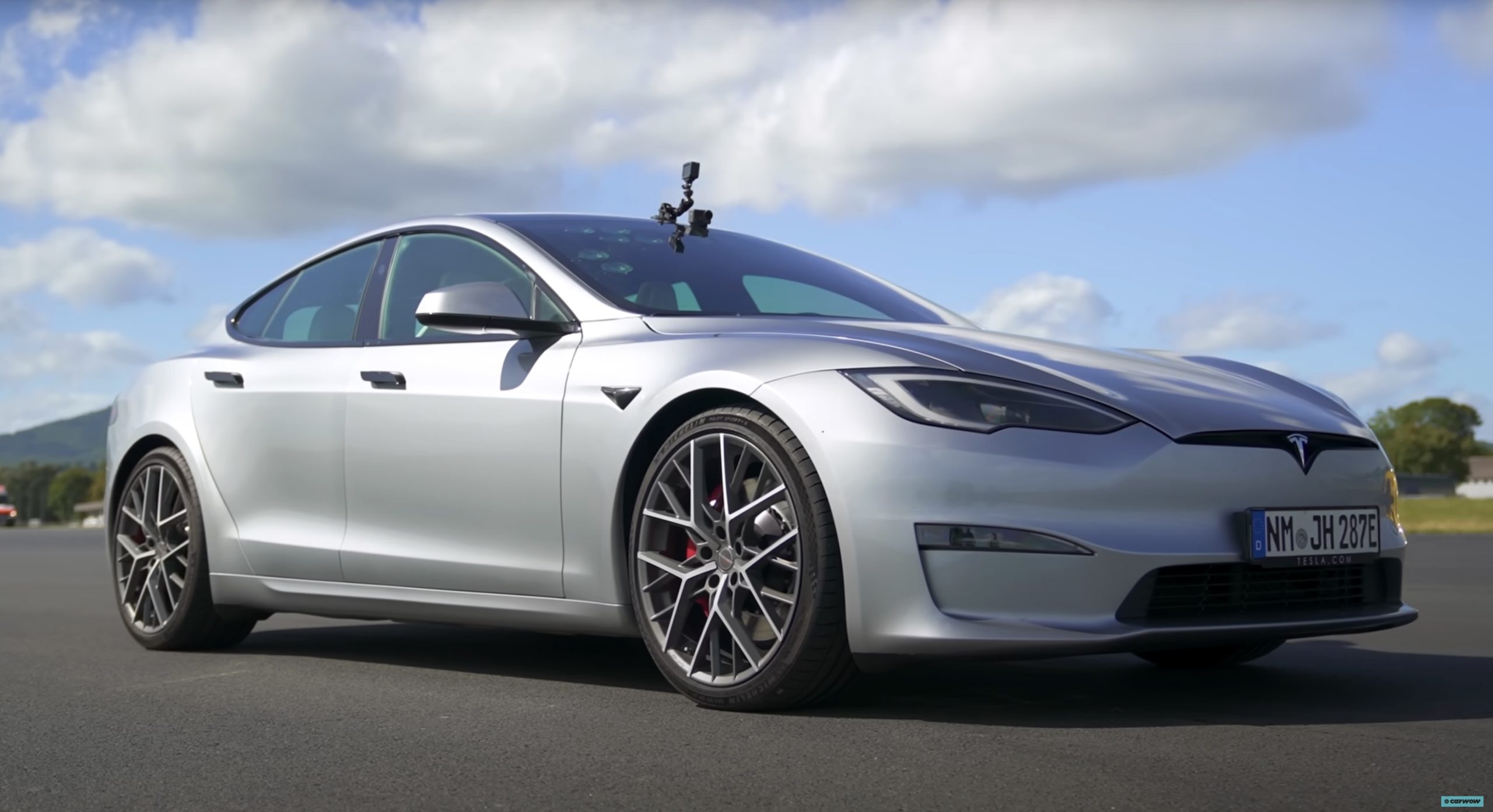
The Tesla Model S Plaid has been around for some time. Today, it is no longer the world’s quickest four-door electric sedan, nor is it the most powerful. As per a recent video from motoring YouTube channel Carwow, however, it seems like the Model S Plaid is still more than a match for some of its newer and more powerful rivals.
The monster from China
The Xiaomi SU7 Ultra is nothing short of a monster. Just like the Model S Plaid, it features three motors. It also has 1,548 hp and 1,770 Nm of torque. It’s All Wheel Drive and weighs a hefty 2,360 kg. The vehicle, which costs just about the equivalent of £55,000, has been recorded setting an insane 7:04.957 at the Nurburgring, surpassing the previous record held by the Porsche Taycan Turbo GT.
For all intents and purposes, the Model S Plaid looked outgunned in Carwow’s test. The Model S Plaid is no slouch with its three motors that produce 1,020 hp and 1,420 Nm of torque. It’s also a bit lighter at 2,190 kg despite its larger size. However, as the Carwow host pointed out, the Model S Plaid holds a 7:25.231 record in the Nurburgring. Compared to the Xiaomi SU7 Ultra’s record, the Model S Plaid’s lap time is notably slower.
Real-world tests
As could be seen in Carwow’s drag races, however, Tesla’s tech wizardry with the Model S Plaid is still hard to beat. The two vehicles competed in nine races, and the older Model S Plaid actually beat its newer, more powerful counterpart from China several times. At one point in the race, the Xiaomi SU7 Ultra hit its power limit due to its battery’s temperature, but the Model S Plaid was still going strong.
The Model S Plaid was first teased five years ago, in September 2020 during Tesla’s Battery Day. Since then, cars like the Lucid Air Sapphire and the Xiaomi SU7 Ultra have been released, surpassing its specs. But just like the Model Y ended up being the better all-rounder compared to the BYD Sealion 7 and the MG IM6, there is just something about Tesla’s tuning and refinement that makes raw specs seem not as game-changing.
Check out Carwow’s Model S Plaid vs Xiaomi SU7 drag race video below.
Lifestyle
500-mile test proves why Tesla Model Y still humiliates rivals in Europe
On paper, the BYD Sealion 7 and MG IM6 promised standout capabilities against the Model Y.
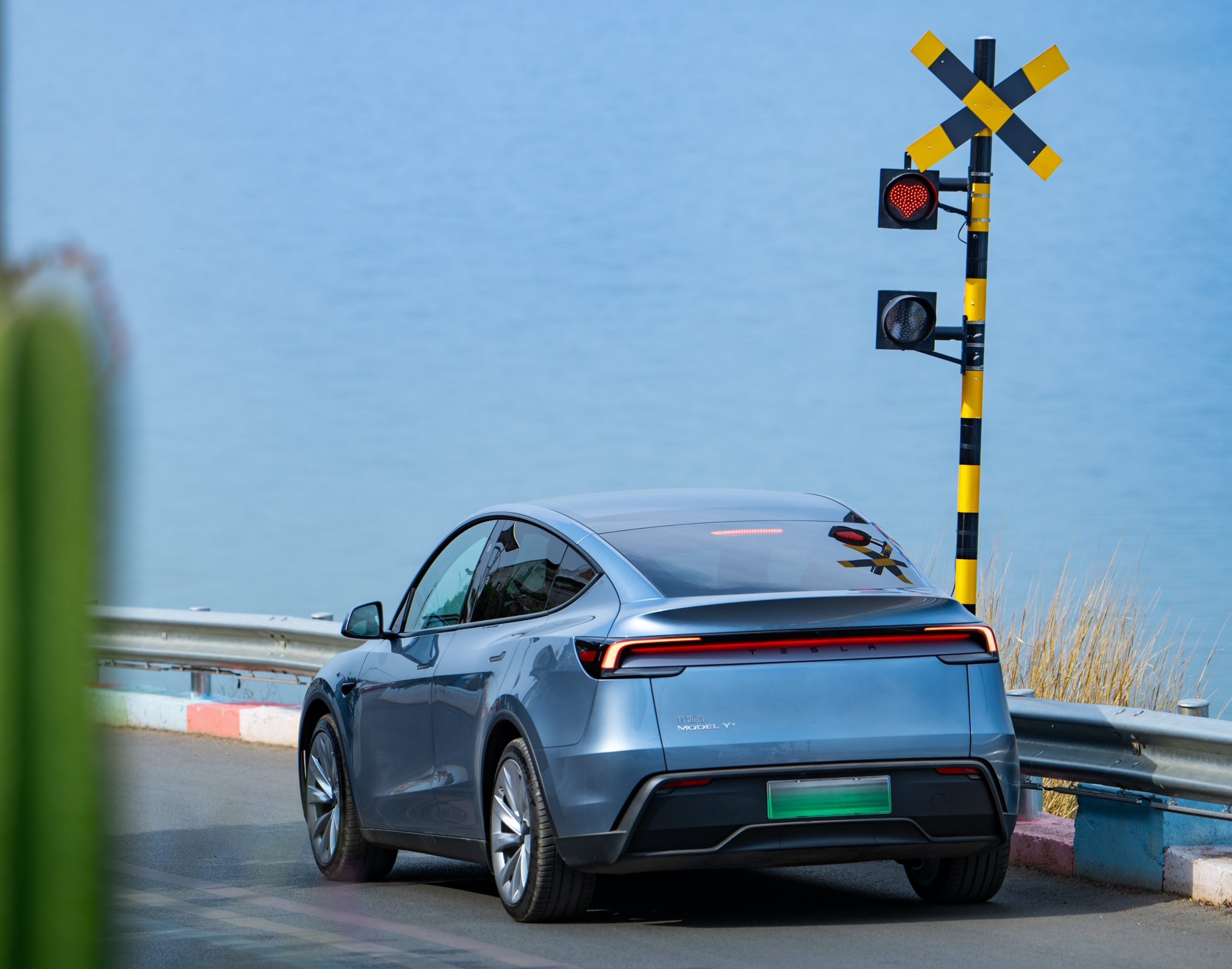
BYD is seeing a lot of momentum in Europe, so much so that mainstream media has taken every opportunity to argue that the Chinese automaker has beaten Tesla in the region. But while BYD sales this year in Europe are rising and Tesla’s registrations remain challenged, the raw capabilities of vehicles like the Model Y are difficult to deny.
This was highlighted in a 500-mile challenge by What Car? magazine, which showed that the new Tesla Model Y is more efficient, cheaper to run, and more reliable than rivals like the BYD Sealion 7, and even the nearly 400 KW-charging MG IM6.
Range and charging promises
On paper, the BYD Sealion 7 and MG IM6 promised standout capabilities against the Model Y. The Sealion 7 had more estimated range and the IM6 promised significantly faster charging. When faced with real-world conditions, however, it was still the Model Y that proved superior.
During the 500-mile test, the BYD nearly failed to reach a charging stop, arriving with less range than its display projected, as noted in a CarUp report. MG fared better, but its charging speeds never reached its promised nearly-400 kW charging speed. Tesla’s Model Y, by comparison, managed energy calculations precisely and arrived at each stop without issue.
Tesla leads in areas that matter
Charging times from 25% to 80% showed that the MG was the fastest at 17 minutes, while Tesla and BYD were close at 28 and 29 minutes, respectively. Overall efficiency and cost told a different story, however. The Model Y consumed 19.4 kWh per 100 km, compared to 22.2 for MG and 23.9 for BYD. Over the full trip, Tesla’s charging costs totaled just £82 thanks to its supercharger network, far below BYD’s £130 and MG’s £119.
What Car? Magazine’s testers concluded that despite BYD’s rapid sales growth and the MG IM6’s seriously impressive charging speeds, Tesla remains the more compelling real-world choice. The Model Y just offers stability, efficiency, and a proven charging infrastructure through its Supercharging network. And as per the magazine’s hosts, the Model Y is even the cheapest car to own among the three that were tested.
Watch What Car? Magazine’s 500-mile test in the video below.
Lifestyle
Tesla Cybertruck slapped with world’s least intimidating ticket, and it’s pure cringe
One cannot help but cringe and feel second-hand embarrassment at the idea of a person just driving around with a stack of these babies.
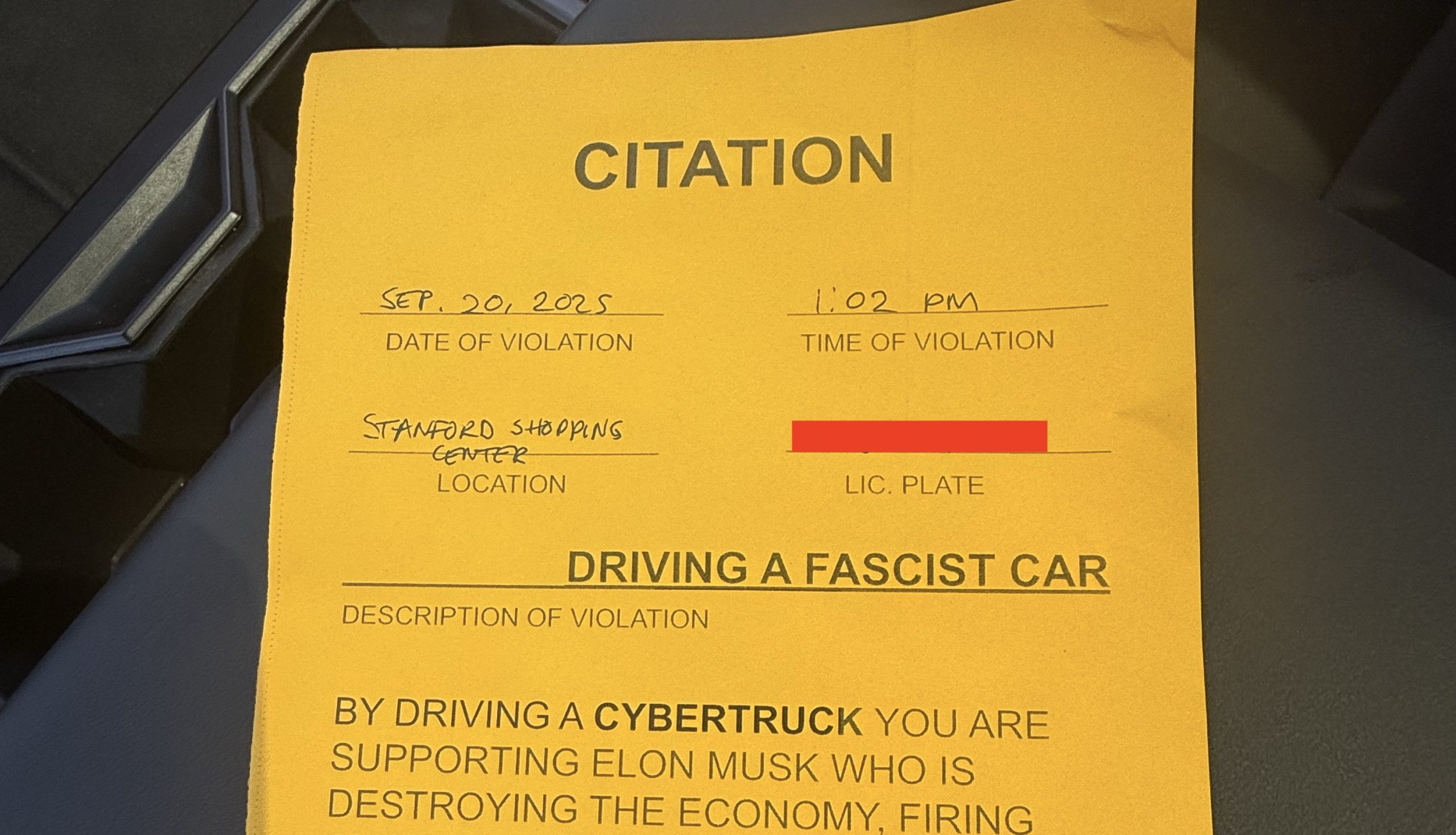
A Cybertruck parked at Stanford Shopping Center in California was recently hit with what might be the most try-hard piece of paper ever slipped under a wiper blade: a “fake citation” accusing the driver of supporting a “fascist car.”
The note, shared on X by Tesla staff program manager Ryan Torres, quickly made the rounds on X, where it quickly gained attention as an example of how not to protest.
The world’s least intimidating ticket
According to the citation, the supposed “violation” was “driving a fascist car.” The remedial action? Take the bus, call an Uber, or ride a bike. The note also dubbed Elon Musk a “chainsaw-wielding Nazi billionaire.” Now, protests against Tesla and Elon Musk have become commonplace this year, but one cannot help but cringe and feel second-hand embarrassment at the idea of a person just driving around with a stack of fake anti-Tesla/Musk citations.
Torres pointed out the irony himself in his post on X. Tesla currently employs over 140,000 Americans, and SpaceX has put the U.S. firmly back at the top of space technology. As Torres put it, maybe the person behind the world’s least intimidating ticket should “read a book on innovation before vandalizing” other people’s property.
Peak performative clownery
Not to mention that the fake ticket’s logic collapses under its own weight. EVs like the Cybertruck are literally designed to reduce emissions, not “destroy the economy.” If anything, Tesla has bolstered the United States’ economy by fueling jobs in engineering, manufacturing, and clean energy. It’s not the first time a Tesla has been the target of vandalism or politically charged notes, but this one stands out for sheer cringe value.
Torres summed it up neatly: “Peak clownery.” On that point, at least, the citation earns full marks. In a way, though, perhaps cringe fake tickets are not as bad as the literal firebombs that were being thrown at Tesla stores and cars earlier this year because some critics were gleefully misinformed about Elon Musk.

